
Take a shot
By Chris Windsor
Features Tech tipsThe growth of refurbishing existing concrete is quickly on the rise for both commercial and residential consumers. Expanding your product offering for your rental business is always something to consider carefully.
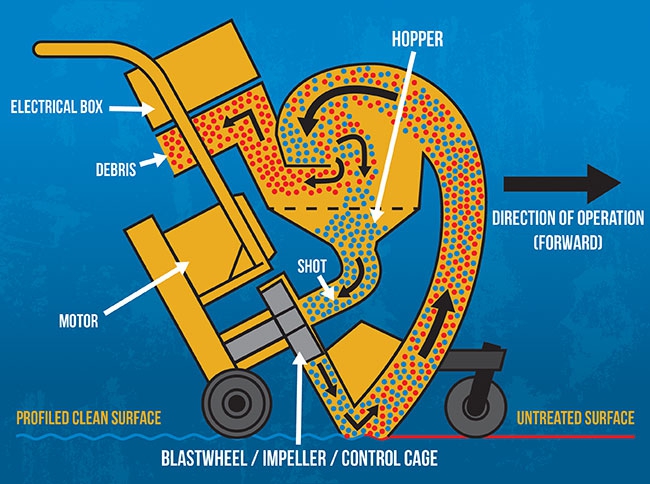 The growth of refurbishing existing concrete is quickly on the rise for both commercial and residential consumers.
The growth of refurbishing existing concrete is quickly on the rise for both commercial and residential consumers.Shotblasting equipment can be a valuable addition to your concrete-processing offering.
Making the right choices when purchasing any type of equipment can mean a very lucrative return on each item you purchase, but making the wrong choice could end up costing your company thousands of dollars in lost revenue and the additional cost of maintaining the equipment. So what are the factors to consider when purchasing a shotblaster for your rental fleet? Like any piece of equipment you consider, there are three major elements to keep in mind.
The first thing to consider is your return on investment for the item you are purchasing. In the rental business, any purchase is measured by how many rents it will take to get your dollar investment back. For example if your equipment investment is $10,000 and the machine has a potential to rent at $500 per day, your payback period is 20 rents before the machine starts to turn a profit and return on your investment. Shotblasting provides great rental rates that will begin to generate ROI quickly.
Everyone in the industry knows how hard the end-user is on equipment. Whether it is because of lack of knowledge regarding use, too many inexperienced operators or extreme operating environments, your machine will take a beating. So along with being well made, the equipment needs to be easy to clean, easy to maintain and, on occasion, easy to repair. With shotblasting equipment, cleanliness greatly enhances the life of the unit and its dust-collector unit. Concrete dust fine and extremely stubborn when adhering to surfaces. An air gun and a damp rag can provide many years of trouble-free service. Wear parts such as manganese liners are easily replaced when required, and when repairs are needed the machine’s simple design and simple components are easily attainable from most electric supply houses.
The last major consideration is the uniqueness of the item being rented. If the item is very common and attainable through most competing rental firms then the cost of the item is reduced to stay competitive and entice customers to your business over that of a competitor’s. But when you are the only source for the rental of a certain tool you can justify and charge greater fees.
So that’s the thinking when considering a shotblaster as a tool for your rental business. But what exactly is shotblasting and what are the most common applications of it?
Shotblasting is one of the most effective ways to prep concrete and steel, which is the reason it has been around for so long. Whether a customer needs to prep a floor to apply a coating or open up the floor to expose aggregate before polishing, shotblasting produces an amazing end result. Because of its numerous uses, shotblasting is frequently the best option for a wide variety of job types when it comes to floor preparation. The target market for shotblasters are surface preparation contractors and homeowners who are applying coatings to their garage or basement floors.
The principle of shotblasting involves throwing steel shot abrasive at a high velocity into the concrete or steel surface. The throwing action is achieved by the shot going through a rotating paddle wheel where it is then fired at a high velocity towards the surface. The energy placed into the abrasive is sufficient to break away particles of the surface and rebound both shot and debris into the separation chamber in the top of the blaster. The steel shot drops back into the paddle wheel chamber and is recycled, while the lighter debris is sucked into the dust collector system for disposal.
As stated above, there are two major applications of shotblasting: surface preparation and surface cleaning. Shotblasting provides extreme versatility in either application with excellent results. Producing a surface profile on the substrate will create optimal adhesion properties for the application of epoxy coatings, paints, overlayment systems and waterproofing membranes. Shotblasting is often recommended by major coating manufacturers to prepare the floor most effectively. Users can also create or re-instate slip-resistant properties or expose aggregate before polishing.
Removing the existing material from the substrate removes surface contaminants, paints and sealants and laitance. With the advancement of coatings and overlayment products, shotblasters are being used as an exceptional surface preparation method in a variety of commercial and industrial settings including manufacturing, food processing, retail and waterproofing for parking garages.
In the steel industry, the two primary applications (produce a profile, remove existing material) are the same as concrete, but the industries in which it is used may differ. The primary use for shotblasting on steel surfaces are on ship decks, steel plates, offshore platforms, Ro-Ro bridges, ferries, foot bridges, and steel storage tanks. These applications can apply to both vertical and horizontal surfaces.
Because shotblasting has been around for so long, you might think that there are hundreds of types to assess and look at. In reality, most shotblasters use similar technology. The main differences that are important to investigate are:
- The direction the operator walks
- The steering technology
- The build quality
There are two main design groups: those machines where the operator walks in a backward motion, away from the blast pattern and those machines that walk forward, over the blast pattern. Forward operation typically provides the operator more ease-of-use and greater control. The majority of shotblasters in the marketplace require the user to operate the machine while they walk backwards. The reason machines were originally engineered this way is not exactly clear. There are, however, some potential issues to consider she operating a machine with backward-motion design.
The first concern is an easy one to spot: safety. Walking backwards restricts the operator’s movements and creates visibility issues as well as increasing tripping hazards. Another concern is that the operator has to look over the machine to inspect the quality of the blast pattern. SPE is one of the only manufacturers that has designed its large shotblasters to allow the operator to walk forward. This results in better visibility of the operator’s sight lines and blast texture. The largest benefit to the forward motion design is the increased safety produced for the operator.
With regards to steering, there are again two main design approaches. Those machines that have hydraulic steering allow the operator to spin on its axis to return the unit backwards beside the last blast pattern, and those that have a steer handle require the operator to make large “S” pattern movements to turn the machine. Shotblasters, by design, are heavy units. They are designed with heavy steel and manganese metal construction in order to withstand the harsh process. With any type of heavy equipment, manoeuvering is a key element. There are two main types of steering technology. One is a handle that extends off the back of the blaster and works like a pivot point, and the other is hydraulic. The advantage of the handle steering method is that it removes the need for mechanical steering and relies on the operator’s manual power. The disadvantage is that it makes the machine design extended and difficult to move in small spaces. With hydraulic steering, there is a zero turning radius which gives the operator easy manoeuvrability in any type of space.
With most equipment, build quality is essential to consider when making a purchase. With shotblasters, it is no different. One of the most important factors to consider is where it is made. Offshore manufacturing often provides an economical advantage, but overall quality may suffer.
As a result quality control in the area of material composition, overall unit construction, and internal component design may suffer. The results are machines that look similar and initially function similarly, but in the long run, fail and break down, costing more in project down time and service problems.
With any piece of equipment, there is always a learning curve. Shotblasters, (especially the smaller ones) are user-friendly to operate with some basic training. Most manufacturers provide training on their machines (some for free, some not). The type of training needed really goes back to who your market is. Most contractors who are involved in surface preparation know how to operate the machines without an issue, but if you are trying to introduce this to a new market that has no concept of shotblasting, that could involve different training.
This depends largely on who your market is. If you deal with contractors who sometimes need to prepare a small space, a nine-inch, self propelled blaster would be a great option. Once contractors are preparing anything over a few thousand square feet, they need something bigger. That is when a 12- or 16-inch would be a better option. Think of the nine-inch like the DIY unit, and the 12- or 16-inch as the professional version. For a nine-inch blaster with a dust collector, you will be looking around $15,000, and for a 12-inch system, around $35,000. That may seem like a big price tag, but when you take into account the lifespan and rental rate, these machines bring in great ROI.
With all of this information at your disposal, you should now have a greater understanding of what shotblasting is, what they are used for, and how to tell good from not-so-good. Shotblasters are very versatile machines that will bring a new aspect to your rental fleet. Maybe it’s just the thing you have been looking for.
How shotblasting works
- Shot is loaded in the hopper of the machine. The hopper acts as a funnel to direct the shot to the shot valve
- The shot valve or butterfly valve controls the volume of shot that is allowed to flow down a spout and into the blast housing. The more shot released, the greater the impact on the surface. The shot valve is controlled by a cable or lever located in the operator’s position for easy accessibility
- After passing through the shot valve the flow of shot is directed by a control cage. This allows the shot to fall on the optimal position of the blast wheel. The control cage can be calibrated and adjusted to ensure that the shotblaster is achieving an even blast pattern across the width of the machine
- After passing through the control cage, the shot is impacted by the blast wheel and travels at a high velocity towards the floor. Depending on the size of the machine, the blast wheel can either be a one piece unit, or made up of a centre housing with a series of blades (paddles)
- The abrasive impact force of the shot hitting the floor removes surface contaminants, leaving a clean, dry profile
- The rebounded shot and debris then travel up the reclaim channel and land on a shelf located directly above the hopper. Once the shelf becomes full, the shot and debris overflow off the shelf. The lighter debris particles are removed by the suction provided by dust collector, and the heavier shot is recycled back into the hopper
- The process described above is a continuous cycle. Over time the shot breaks down (wears away) and new shot needs to be added to the hopper to replenish it
Chris Windsor is marketing manager for the Bartell Family of Companies.
Print this page
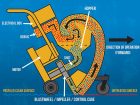
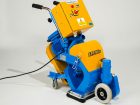
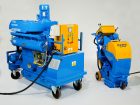
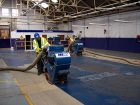
Leave a Reply